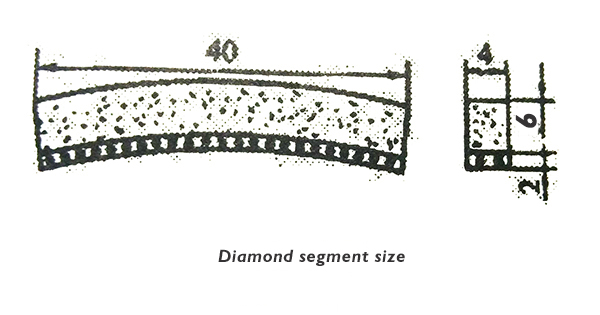When makingdiamond segment, it is very important to accurately calculate the material usedfor each segment, especially in the process of daily making segment. Only afterrefining and mastering the material used for the transition layer and theworking layer, can we start making segment .The following is an example of howthe amount of all materials used in the forming process of a diamond segment iscalculated.

If we want tomake a diamond segment of a marble saw blade with a length, width and height of 40*4*8, the size of the segment is shown in the figure. The binder formingdensity is 10.0g/cm3, the diamond density is 3.52g/cm3, and the volumeconcentration of diamond used in the segment is 10%.It is required to calculatethe amount of material used for the working layer (diamond and matrix) andwelding layer.
Work out the volumeof working layer:V (work)=40×4×6=960mm3=0.96cm3
Calculate thevolume of welding layer: V i =40×4×2=0.32cm3
According to theselected binder, its forming density was calculated to be 10.0g/cm3
Calculate theamount of diamond and binder for each diamond segment:Since the volumeconcentration of diamond in the block is 10%, the volume of diamond in theworking layer is: V (dia) = 9.6 cm3 x 10% = 0.096 cm3
The weight ofdiamond required is: G (dia) =3.52*V=0.33792g
The volume occupiedby partial binder of working layer is: V matrix=V (work)-V (dia) =0.864cm3
Weight of binderrequired: G matrix=10Vmatrix=8.64g
The total weight ofworking layer is: G= G matrix+ G dia =8.97792g
Weight of weldinglayer binder: G i=10Vi=3.2g
Theabove is the lump volume calculated separately. If the components aresubdivided, for example, the proportion of iron and copper in the binder is 10percent and 8 percent respectively. Then, the proportion of all ingredients inthe whole diamond tool head can be calculated by multiplying the total weightof the binder by the corresponding proportion, thus providing a comparisonbasis for weighing in the early stage.





